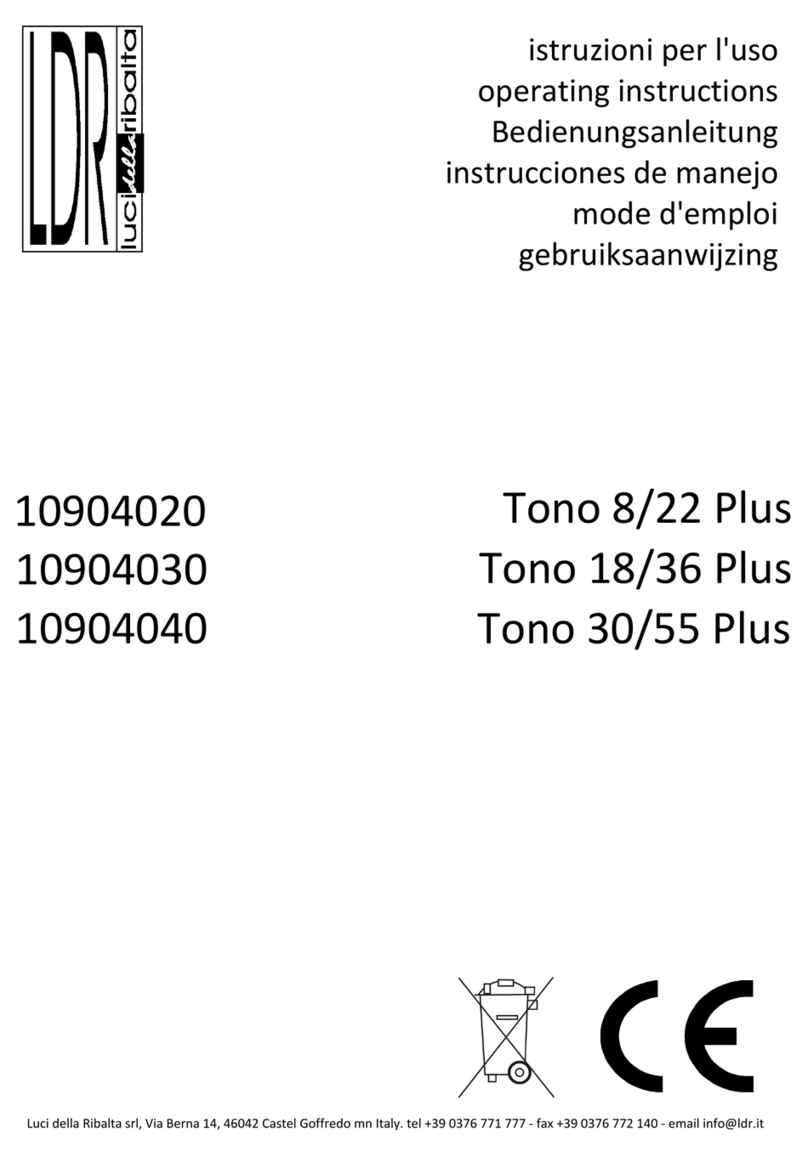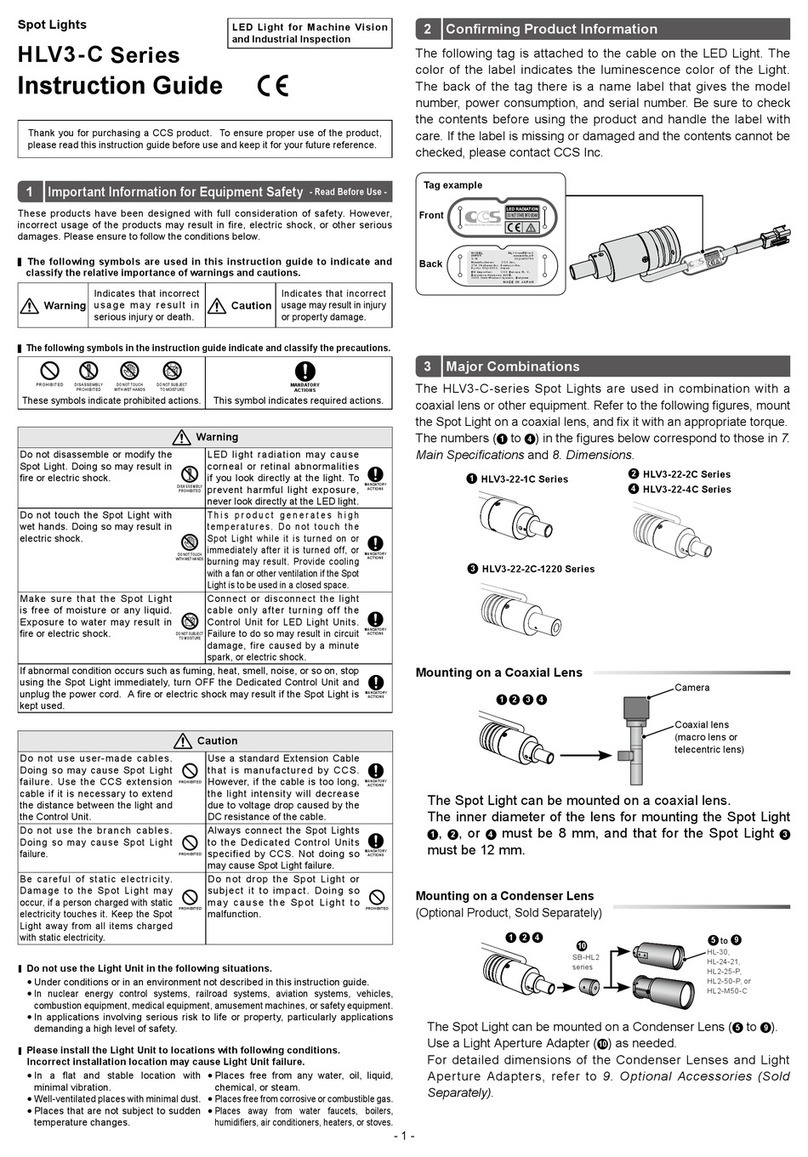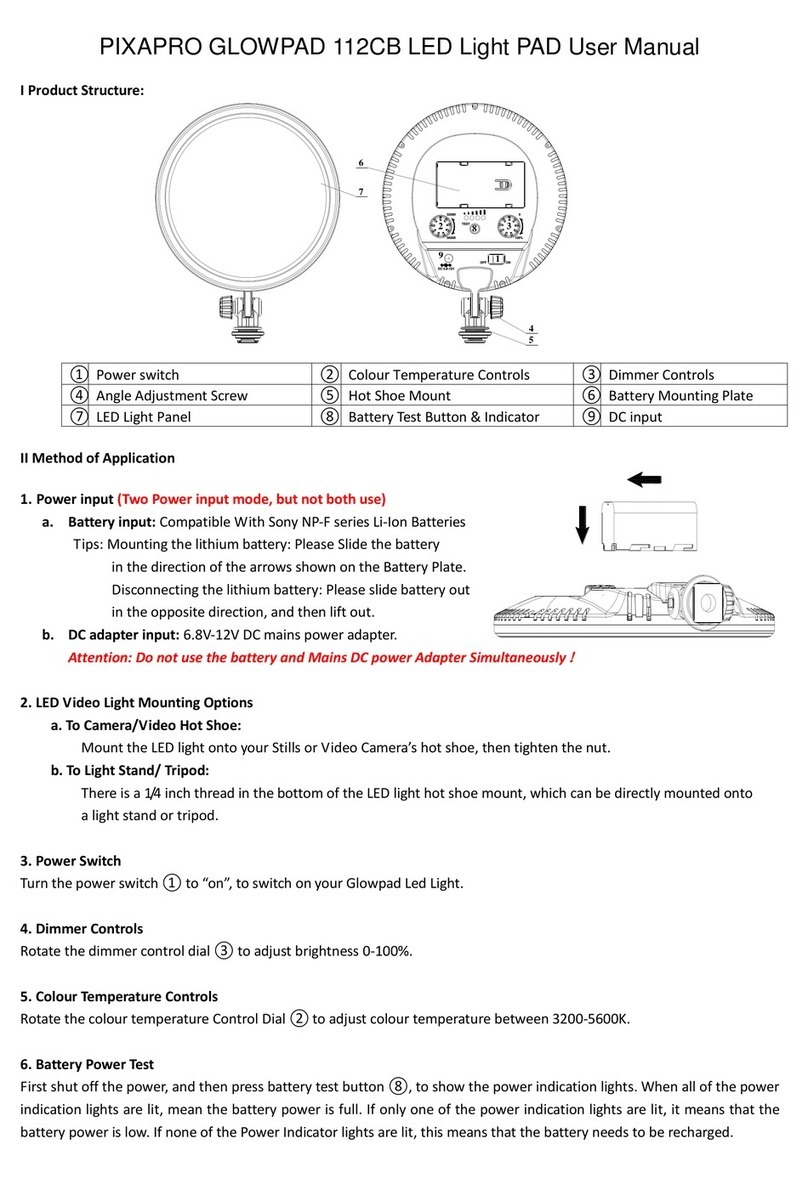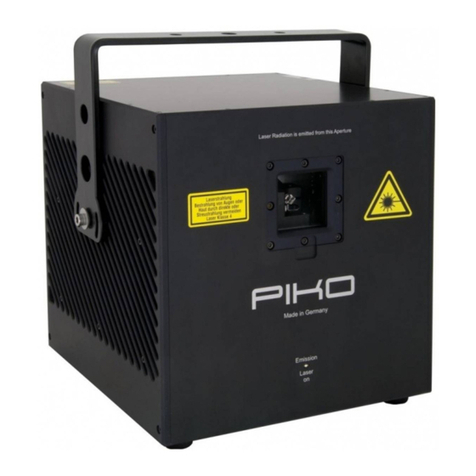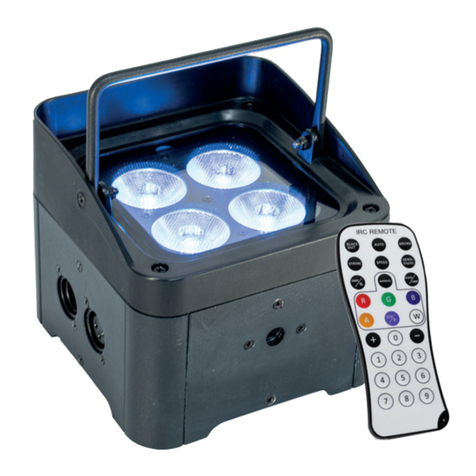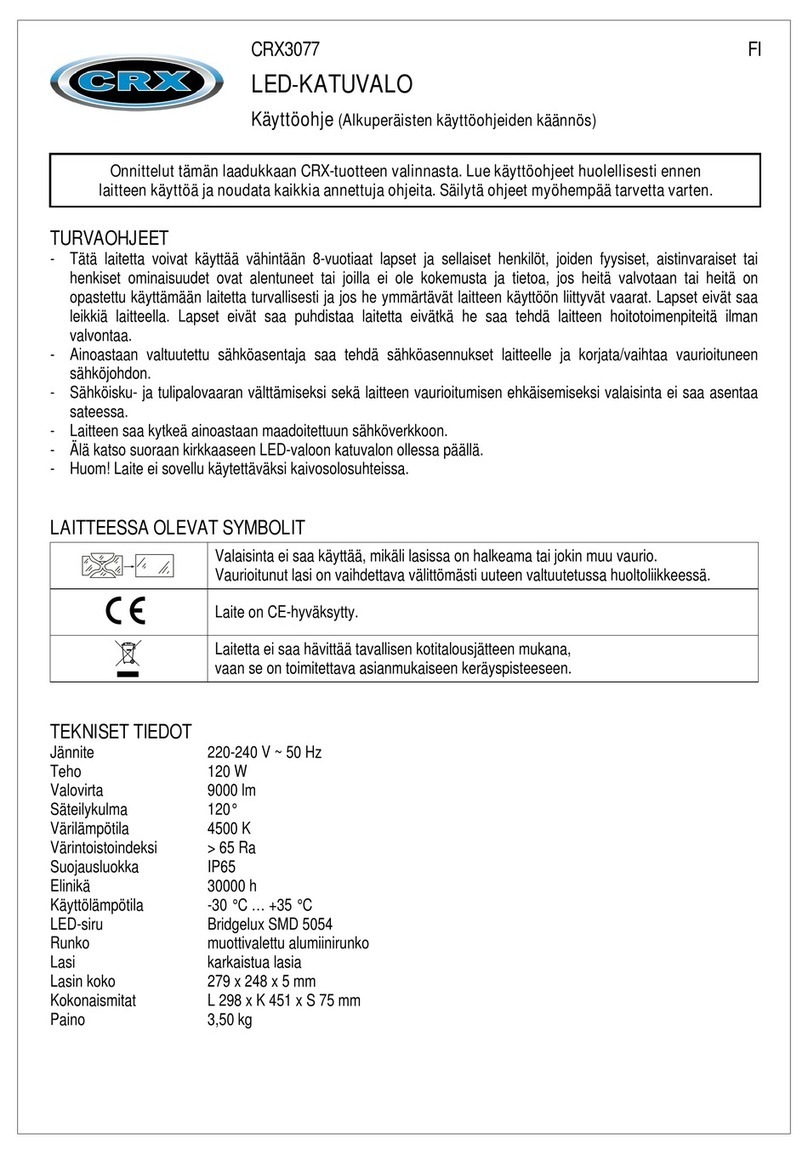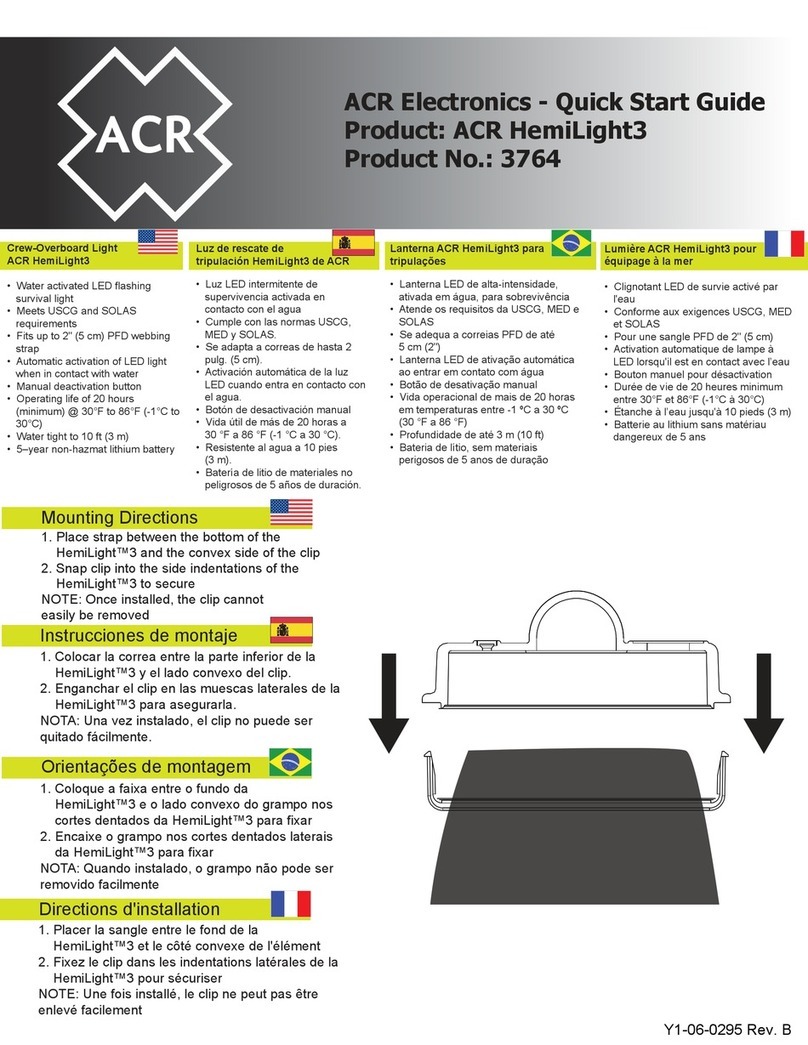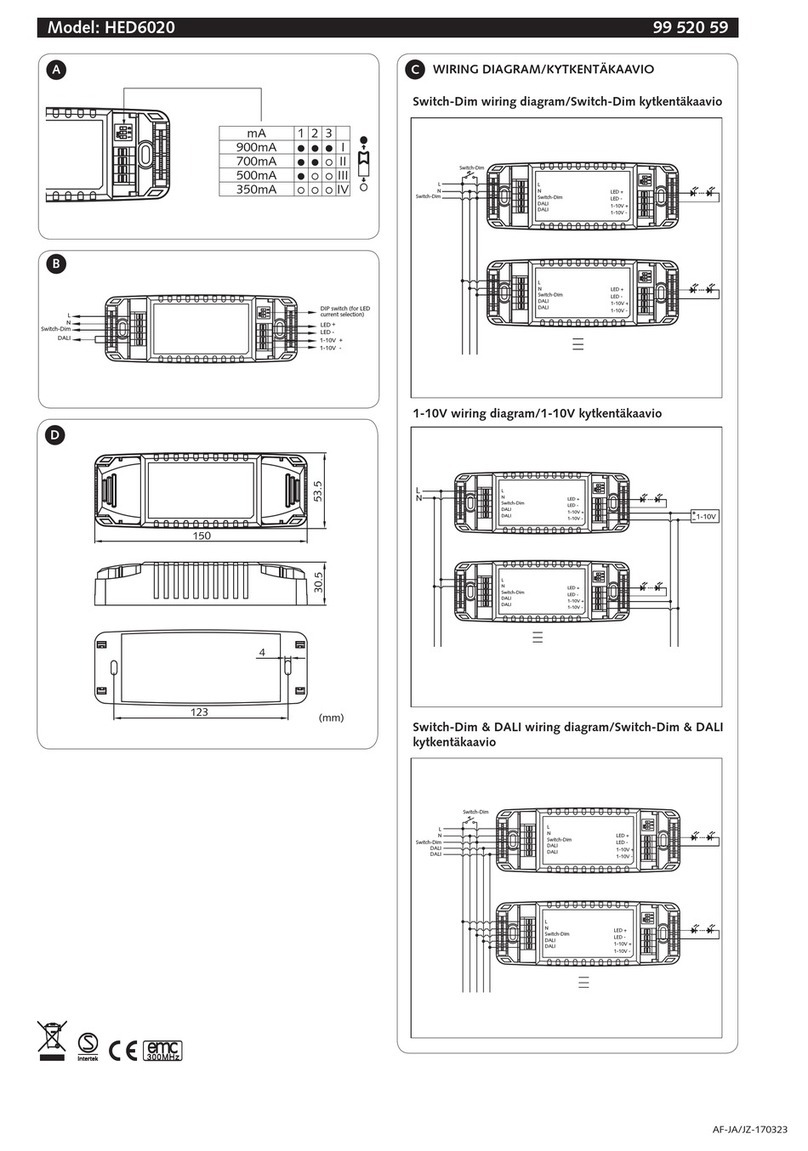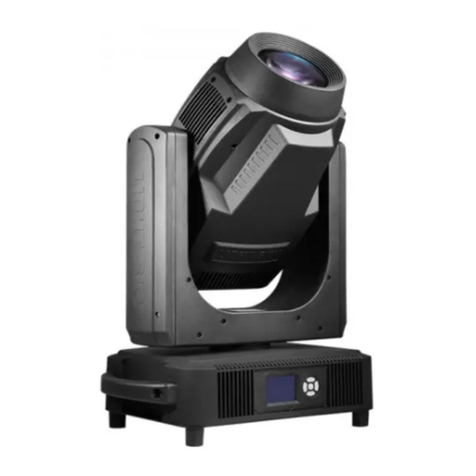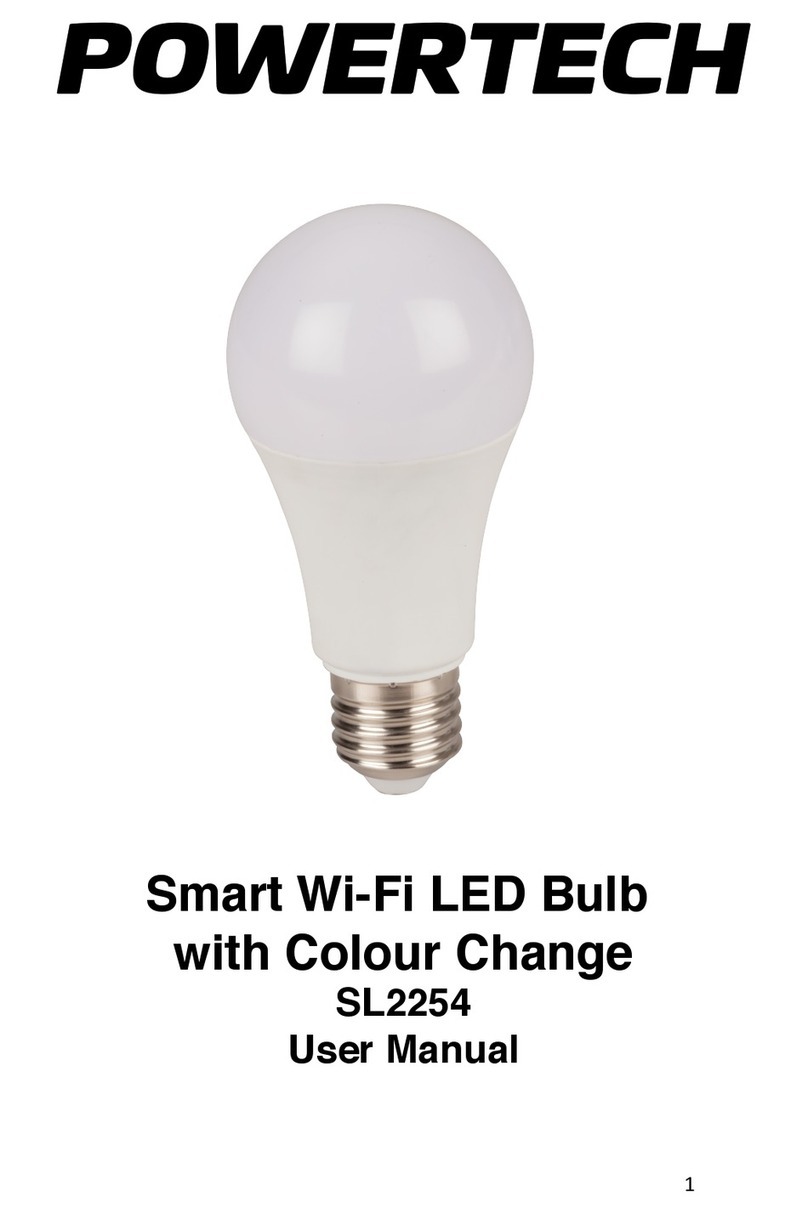Flash Technology FTB 312-3 User manual

Flash Technology Corporation of America®, 332 Nichol Mill Lane, Franklin TN 37067
(615) 261-2000
SN
FTB 312-3, 312-3A, 312-3AE, 312-3T, 312-3TA
FTS 316-2 and 316-2AE
FTS 316-3 and 316-3AE
Dual Medium Intensity,
Obstruction Lighting Systems
Reference Manual

ii Revision13 — 02-20-2001 FTB 312 and FTS 316
Front Matter
Abstract
This document describes the: FTB 312-3, 312-3A, 312-3AE, 312-3T, and 312-3TA; FTS 316-2, 316-2AE, 316-3, and
316-3AE Medium Intensity Obstruction Lighting Systems.
Copyright
Copyright © 1995 - 2001, Flash Technology Corporation of America®, Franklin TN 37067, U.S.A.
All rights reserved. Reproduction or use of any portion of this manual is prohibited without express written per-
mission from Flash Technology Corporation of America and/or its licenser.
Trademark Acknowledgments
Flash Technology Corporation of America® is a registered trademark name.
Flash™, ElectroFlash™, Flash Tech™, Flash Technology™, FTCA™, and the Flash Technology Logo are all
trademarks of Flash Technology Corporation of America®.
All trademarks and product names mentioned are properties of their respective companies, and are recognized
and acknowledged as such by Flash Technology Corporation of America.
Applicable Specification
This equipment meets or exceeds requirements in Advisory Circular 150/5345-43 for FAA Type L-864 and L-865
medium intensity obstruction lights with L-810 markers (side lights).
Disclaimer
While every effort has been made to ensure that the information in this manual is complete, accurate and
up-to-date, Flash Technology Corporation of America assumes no liability for damages resulting from any errors
or omissions in this manual, or from the use of the information contained herein. Flash Technology Corporation of
America reserves the right to revise this manual without obligation to notify any person or organization of the
revision.
In no event will Flash Technology Corporation of America be liable for direct, indirect, special, incidental, or con-
sequential damages arising out of the use of or the inability to use this manual.
Warranty
FTCA warrants all components, under normal operating conditions, for two years.
Parts Replacement
The use of non-OEM parts or unauthorized modification of this equipment will void the warranty and could inval-
idate the assurance of complying with FAA requirements as published in Advisory Circular 150/5345-43.
Pub. No. 0594-312/316-00012

FTB 312 and FTS 316 Revision13 — 02-20-2001 iii
Hazard Warning
PERSONNEL HAZARD WARNING
DANGEROUS VOLTAGES
Dangerous line voltages reside in certain locations in this equipment. Also, this equipment
may generate dangerous voltages. Although FTCA has incorporated every practical safety
precaution, exercise extreme caution at all times when you expose circuits and compo-
nents, and when you operate, maintain, or service this equipment.
Avoid Touching Live Circuits
Avoid touching any component or any part of the circuitry while the equipment is operating.
Do not change components or make adjustments inside the equipment with power on.
Dangerous Voltages Can Persist with Power Disconnected
Under certain conditions, dangerous voltages can be present because capacitors can
retain charges even after the power has been disconnected.
Protect yourself — always turn off the input (primary) power and wait for one minute for
storage capacitors to drain their charge. Then check between the red and blue wires on the
flashhead terminal block with a voltmeter for any residual charge before touching any circuit
element or component.
Do Not Depend on Interlocks
Never depend on interlocks alone to remove unsafe voltages. Always check circuits with a
voltmeter. Under no circumstances remove or alter any safety interlock switch.

iv Revision13 — 02-20-2001 FTB 312 and FTS 316
Table of Contents Page
Front Matter . . . . . . . . . . . . . . . . . . . . . . . . . . . . . . . . . . . . . . . . . . . . . . . . . . . . . . . . . . . . . . . . . . . . . . . . . ii
Section 1 — FTB 312-3 Introduction and Operation . . . . . . . . . . . . . . . . . . . . . . . . . . . . . . . . . . . . . . 1-1
System . . . . . . . . . . . . . . . . . . . . . . . . . . . . . . . . . . . . . . . . . . . . . . . . . . . . . . . . . . . . . . . . . . . . . . . . . . . . . 1-1
FTS 316 Systems . . . . . . . . . . . . . . . . . . . . . . . . . . . . . . . . . . . . . . . . . . . . . . . . . . . . . . . . . . . . . . . . . . 1-1
Specifications . . . . . . . . . . . . . . . . . . . . . . . . . . . . . . . . . . . . . . . . . . . . . . . . . . . . . . . . . . . . . . . . . . . . . . . . 1-1
FIV 1100 and FIV 2000 Power Inverter . . . . . . . . . . . . . . . . . . . . . . . . . . . . . . . . . . . . . . . . . . . . . . . . . . . 1-2
FIV Inverter Operation . . . . . . . . . . . . . . . . . . . . . . . . . . . . . . . . . . . . . . . . . . . . . . . . . . . . . . . . . . . . . 1-2
Protection . . . . . . . . . . . . . . . . . . . . . . . . . . . . . . . . . . . . . . . . . . . . . . . . . . . . . . . . . . . . . . . . . . . . . . . 1-2
System Operation . . . . . . . . . . . . . . . . . . . . . . . . . . . . . . . . . . . . . . . . . . . . . . . . . . . . . . . . . . . . . . . . . . . . 1-4
PCB1 Timing and Trigger Board . . . . . . . . . . . . . . . . . . . . . . . . . . . . . . . . . . . . . . . . . . . . . . . . . . . . . 1-4
Setting Up PCB1 . . . . . . . . . . . . . . . . . . . . . . . . . . . . . . . . . . . . . . . . . . . . . . . . . . . . . . . . . . . . . . . . . . 1-4
Function Indicators . . . . . . . . . . . . . . . . . . . . . . . . . . . . . . . . . . . . . . . . . . . . . . . . . . . . . . . . . . . . 1-4
PCB1 24740xx . . . . . . . . . . . . . . . . . . . . . . . . . . . . . . . . . . . . . . . . . . . . . . . . . . . . . . . . . . . . . . . . . 1-4
PCB1 24747xx . . . . . . . . . . . . . . . . . . . . . . . . . . . . . . . . . . . . . . . . . . . . . . . . . . . . . . . . . . . . . . . . . 1-4
Photocell . . . . . . . . . . . . . . . . . . . . . . . . . . . . . . . . . . . . . . . . . . . . . . . . . . . . . . . . . . . . . . . . . . . . . . . . . . . . 1-6
Power Converter Main Panel: Alarms and Signals . . . . . . . . . . . . . . . . . . . . . . . . . . . . . . . . . . . . . . . . . . 1-6
Master/Slave Interconnect . . . . . . . . . . . . . . . . . . . . . . . . . . . . . . . . . . . . . . . . . . . . . . . . . . . . . . . . . . 1-7
Section 2 — Outline, Mounting, Installation . . . . . . . . . . . . . . . . . . . . . . . . . . . . . . . . . . . . . . . . . . . . . 2-1
Unpacking . . . . . . . . . . . . . . . . . . . . . . . . . . . . . . . . . . . . . . . . . . . . . . . . . . . . . . . . . . . . . . . . . . . . . . . . . . 2-1
Tools . . . . . . . . . . . . . . . . . . . . . . . . . . . . . . . . . . . . . . . . . . . . . . . . . . . . . . . . . . . . . . . . . . . . . . . . . . . . . . . 2-1
Access . . . . . . . . . . . . . . . . . . . . . . . . . . . . . . . . . . . . . . . . . . . . . . . . . . . . . . . . . . . . . . . . . . . . . . . . . . . . . . 2-1
Power Converter . . . . . . . . . . . . . . . . . . . . . . . . . . . . . . . . . . . . . . . . . . . . . . . . . . . . . . . . . . . . . . . . . . 2-1
Flashhead . . . . . . . . . . . . . . . . . . . . . . . . . . . . . . . . . . . . . . . . . . . . . . . . . . . . . . . . . . . . . . . . . . . . . . . 2-1
Mounting . . . . . . . . . . . . . . . . . . . . . . . . . . . . . . . . . . . . . . . . . . . . . . . . . . . . . . . . . . . . . . . . . . . . . . . . . . . 2-1
Power Converter . . . . . . . . . . . . . . . . . . . . . . . . . . . . . . . . . . . . . . . . . . . . . . . . . . . . . . . . . . . . . . . . . . 2-1
Flashhead . . . . . . . . . . . . . . . . . . . . . . . . . . . . . . . . . . . . . . . . . . . . . . . . . . . . . . . . . . . . . . . . . . . . . . . 2-1
Leveling . . . . . . . . . . . . . . . . . . . . . . . . . . . . . . . . . . . . . . . . . . . . . . . . . . . . . . . . . . . . . . . . . . . . . . 2-2
Photocell . . . . . . . . . . . . . . . . . . . . . . . . . . . . . . . . . . . . . . . . . . . . . . . . . . . . . . . . . . . . . . . . . . . . . . . . 2-2
Red Light Fixtures . . . . . . . . . . . . . . . . . . . . . . . . . . . . . . . . . . . . . . . . . . . . . . . . . . . . . . . . . . . . . . . . 2-2
Installation Wiring . . . . . . . . . . . . . . . . . . . . . . . . . . . . . . . . . . . . . . . . . . . . . . . . . . . . . . . . . . . . . . . . . . . 2-2
Power Converter Wiring . . . . . . . . . . . . . . . . . . . . . . . . . . . . . . . . . . . . . . . . . . . . . . . . . . . . . . . . . . . . 2-2
Power Service Wiring . . . . . . . . . . . . . . . . . . . . . . . . . . . . . . . . . . . . . . . . . . . . . . . . . . . . . . . . . . . 2-2
Flashhead Wiring . . . . . . . . . . . . . . . . . . . . . . . . . . . . . . . . . . . . . . . . . . . . . . . . . . . . . . . . . . . . . . . . . 2-3
Securing the Cable . . . . . . . . . . . . . . . . . . . . . . . . . . . . . . . . . . . . . . . . . . . . . . . . . . . . . . . . . . . . . 2-3
Photocell Wiring . . . . . . . . . . . . . . . . . . . . . . . . . . . . . . . . . . . . . . . . . . . . . . . . . . . . . . . . . . . . . . . . . . 2-3
Master/Slave Interconnect Wiring . . . . . . . . . . . . . . . . . . . . . . . . . . . . . . . . . . . . . . . . . . . . . . . . . . . . 2-3
FTS 316-2 and FTS 316-3 DC Back-Up Power Source . . . . . . . . . . . . . . . . . . . . . . . . . . . . . . . . . . . . 2-4
Alarm Relay Wiring . . . . . . . . . . . . . . . . . . . . . . . . . . . . . . . . . . . . . . . . . . . . . . . . . . . . . . . . . . . . . . . 2-4
Installation Checklist . . . . . . . . . . . . . . . . . . . . . . . . . . . . . . . . . . . . . . . . . . . . . . . . . . . . . . . . . . . . . . . . . 2-4
Section 3 — Maintenance and Troubleshooting . . . . . . . . . . . . . . . . . . . . . . . . . . . . . . . . . . . . . . . . . . 3-1
Safety . . . . . . . . . . . . . . . . . . . . . . . . . . . . . . . . . . . . . . . . . . . . . . . . . . . . . . . . . . . . . . . . . . . . . . . . . . . . . . 3-1
Preventive Maintenance . . . . . . . . . . . . . . . . . . . . . . . . . . . . . . . . . . . . . . . . . . . . . . . . . . . . . . . . . . . . . . . 3-1
Storage . . . . . . . . . . . . . . . . . . . . . . . . . . . . . . . . . . . . . . . . . . . . . . . . . . . . . . . . . . . . . . . . . . . . . . . . . . . . . 3-1
Diagnostic Testing . . . . . . . . . . . . . . . . . . . . . . . . . . . . . . . . . . . . . . . . . . . . . . . . . . . . . . . . . . . . . . . . . . . . 3-1
Sync Signal Evaluation . . . . . . . . . . . . . . . . . . . . . . . . . . . . . . . . . . . . . . . . . . . . . . . . . . . . . . . . . . . . . 3-1
RFI Problems . . . . . . . . . . . . . . . . . . . . . . . . . . . . . . . . . . . . . . . . . . . . . . . . . . . . . . . . . . . . . . . . . . . . . 3-2
Component Testing . . . . . . . . . . . . . . . . . . . . . . . . . . . . . . . . . . . . . . . . . . . . . . . . . . . . . . . . . . . . . . . . . . . 3-2
Wiring and Cabling . . . . . . . . . . . . . . . . . . . . . . . . . . . . . . . . . . . . . . . . . . . . . . . . . . . . . . . . . . . . . . . . 3-2
Inspection . . . . . . . . . . . . . . . . . . . . . . . . . . . . . . . . . . . . . . . . . . . . . . . . . . . . . . . . . . . . . . . . . . . . . . . 3-2

FTB 312 and FTS 316 Revision13 — 02-20-2001 v
Table of Contents (cont’d) Page
Power Converter Component Testing . . . . . . . . . . . . . . . . . . . . . . . . . . . . . . . . . . . . . . . . . . . . . . . . . 3-2
Capacitors . . . . . . . . . . . . . . . . . . . . . . . . . . . . . . . . . . . . . . . . . . . . . . . . . . . . . . . . . . . . . . . . . . . . 3-2
Burst Choke (L1) . . . . . . . . . . . . . . . . . . . . . . . . . . . . . . . . . . . . . . . . . . . . . . . . . . . . . . . . . . . . . . 3-2
Relays . . . . . . . . . . . . . . . . . . . . . . . . . . . . . . . . . . . . . . . . . . . . . . . . . . . . . . . . . . . . . . . . . . . . . . . 3-2
Timing and Trigger Board (PCB1) . . . . . . . . . . . . . . . . . . . . . . . . . . . . . . . . . . . . . . . . . . . . . . . . 3-3
HV Rectifier Board (PCB2) . . . . . . . . . . . . . . . . . . . . . . . . . . . . . . . . . . . . . . . . . . . . . . . . . . . . . . 3-3
Alarm Relay Board (PCB5) (PC 312-3AE) . . . . . . . . . . . . . . . . . . . . . . . . . . . . . . . . . . . . . . . . . . 3-3
Sense Module (PCB4) . . . . . . . . . . . . . . . . . . . . . . . . . . . . . . . . . . . . . . . . . . . . . . . . . . . . . . . . . . . 3-3
Discharge Resistor (R1) . . . . . . . . . . . . . . . . . . . . . . . . . . . . . . . . . . . . . . . . . . . . . . . . . . . . . . . . . 3-3
Burst Resistor (R2) . . . . . . . . . . . . . . . . . . . . . . . . . . . . . . . . . . . . . . . . . . . . . . . . . . . . . . . . . . . . . 3-3
Power Transformer (T1) . . . . . . . . . . . . . . . . . . . . . . . . . . . . . . . . . . . . . . . . . . . . . . . . . . . . . . . . 3-3
Trigger Coupling Transformer (T3) . . . . . . . . . . . . . . . . . . . . . . . . . . . . . . . . . . . . . . . . . . . . . . . 3-3
Red Light Module Components . . . . . . . . . . . . . . . . . . . . . . . . . . . . . . . . . . . . . . . . . . . . . . . . . . . 3-3
Flashhead Component Testing . . . . . . . . . . . . . . . . . . . . . . . . . . . . . . . . . . . . . . . . . . . . . . . . . . . . . . 3-3
Flashtube (FT101) . . . . . . . . . . . . . . . . . . . . . . . . . . . . . . . . . . . . . . . . . . . . . . . . . . . . . . . . . . . . . 3-3
Trigger Transformer (T101) . . . . . . . . . . . . . . . . . . . . . . . . . . . . . . . . . . . . . . . . . . . . . . . . . . . . . 3-3
Trigger Coupling Transformer (T102) . . . . . . . . . . . . . . . . . . . . . . . . . . . . . . . . . . . . . . . . . . . . . 3-3
Photocell Testing . . . . . . . . . . . . . . . . . . . . . . . . . . . . . . . . . . . . . . . . . . . . . . . . . . . . . . . . . . . . . . . . . 3-3
Component Removal and Replacement . . . . . . . . . . . . . . . . . . . . . . . . . . . . . . . . . . . . . . . . . . . . . . . . . . . 3-4
Power Converter . . . . . . . . . . . . . . . . . . . . . . . . . . . . . . . . . . . . . . . . . . . . . . . . . . . . . . . . . . . . . . . . . . 3-4
Capacitors . . . . . . . . . . . . . . . . . . . . . . . . . . . . . . . . . . . . . . . . . . . . . . . . . . . . . . . . . . . . . . . . . . . . 3-4
Input Power Module . . . . . . . . . . . . . . . . . . . . . . . . . . . . . . . . . . . . . . . . . . . . . . . . . . . . . . . . . . . . 3-5
K2 Mode Relay . . . . . . . . . . . . . . . . . . . . . . . . . . . . . . . . . . . . . . . . . . . . . . . . . . . . . . . . . . . . . . . . 3-5
K3 Discharge Relay . . . . . . . . . . . . . . . . . . . . . . . . . . . . . . . . . . . . . . . . . . . . . . . . . . . . . . . . . . . . 3-5
K5 Marker Control Relay . . . . . . . . . . . . . . . . . . . . . . . . . . . . . . . . . . . . . . . . . . . . . . . . . . . . . . . 3-5
L1 Burst Choke . . . . . . . . . . . . . . . . . . . . . . . . . . . . . . . . . . . . . . . . . . . . . . . . . . . . . . . . . . . . . . . 3-5
PCB1 Timing and Trigger Board . . . . . . . . . . . . . . . . . . . . . . . . . . . . . . . . . . . . . . . . . . . . . . . . . 3-5
PCB2 HV Rectifier Board . . . . . . . . . . . . . . . . . . . . . . . . . . . . . . . . . . . . . . . . . . . . . . . . . . . . . . . 3-5
PCB4 Sense Module . . . . . . . . . . . . . . . . . . . . . . . . . . . . . . . . . . . . . . . . . . . . . . . . . . . . . . . . . . . . 3-6
Red Light Module . . . . . . . . . . . . . . . . . . . . . . . . . . . . . . . . . . . . . . . . . . . . . . . . . . . . . . . . . . . . . . 3-6
R2A and R2B Burst Resistors . . . . . . . . . . . . . . . . . . . . . . . . . . . . . . . . . . . . . . . . . . . . . . . . . . . . 3-6
T1 Power Transformer . . . . . . . . . . . . . . . . . . . . . . . . . . . . . . . . . . . . . . . . . . . . . . . . . . . . . . . . . . 3-6
T3 Trigger Coupling Transformer . . . . . . . . . . . . . . . . . . . . . . . . . . . . . . . . . . . . . . . . . . . . . . . . . 3-6
Flashhead . . . . . . . . . . . . . . . . . . . . . . . . . . . . . . . . . . . . . . . . . . . . . . . . . . . . . . . . . . . . . . . . . . . . . . . 3-6
FT101 Flashtube (FH 306) . . . . . . . . . . . . . . . . . . . . . . . . . . . . . . . . . . . . . . . . . . . . . . . . . . . . . . 3-6
Flashtube Mounting Plate Assembly (FH 306) . . . . . . . . . . . . . . . . . . . . . . . . . . . . . . . . . . . . . . 3-7
Trigger Transformer, T101 (FH 307T, FH 308) . . . . . . . . . . . . . . . . . . . . . . . . . . . . . . . . . . . . . . 3-7
Coupling Transformer, T102 . . . . . . . . . . . . . . . . . . . . . . . . . . . . . . . . . . . . . . . . . . . . . . . . . . . . . 3-7
Operational Checkout . . . . . . . . . . . . . . . . . . . . . . . . . . . . . . . . . . . . . . . . . . . . . . . . . . . . . . . . . . . . . . . . . 3-7
Single-Unit System . . . . . . . . . . . . . . . . . . . . . . . . . . . . . . . . . . . . . . . . . . . . . . . . . . . . . . . . . . . . . . . . 3-7
Multiple-Unit System . . . . . . . . . . . . . . . . . . . . . . . . . . . . . . . . . . . . . . . . . . . . . . . . . . . . . . . . . . . . . . 3-7
Testing Each Unit . . . . . . . . . . . . . . . . . . . . . . . . . . . . . . . . . . . . . . . . . . . . . . . . . . . . . . . . . . . . . . . . . 3-8
PEC Testing . . . . . . . . . . . . . . . . . . . . . . . . . . . . . . . . . . . . . . . . . . . . . . . . . . . . . . . . . . . . . . . . . . . . . 3-8
Checkout Procedures . . . . . . . . . . . . . . . . . . . . . . . . . . . . . . . . . . . . . . . . . . . . . . . . . . . . . . . . . . . . . . 3-8
Troubleshooting the System . . . . . . . . . . . . . . . . . . . . . . . . . . . . . . . . . . . . . . . . . . . . . . . . . . . . . . . . . . . . 3-12
Troubleshooting the FIV Power Inverter . . . . . . . . . . . . . . . . . . . . . . . . . . . . . . . . . . . . . . . . . . . . . . 3-14
Determining Filter Function from the Power Converter . . . . . . . . . . . . . . . . . . . . . . . . . . . . . . . . . . 3-14
Using the Intensity Select Switches — Finding the Failing Unit at Night . . . . . . . . . . . . . . . . . . . 3-15
Section 4 — Recommended Spare and Replaceable Parts . . . . . . . . . . . . . . . . . . . . . . . . . . . . . . . . . . 4-1
Customer Service . . . . . . . . . . . . . . . . . . . . . . . . . . . . . . . . . . . . . . . . . . . . . . . . . . . . . . . . . . . . . . . . . . . . 4-1
Ordering Parts . . . . . . . . . . . . . . . . . . . . . . . . . . . . . . . . . . . . . . . . . . . . . . . . . . . . . . . . . . . . . . . . . . . . . . 4-1

vi Revision13 — 02-20-2001 FTB 312 and FTS 316
Power Converter Parts . . . . . . . . . . . . . . . . . . . . . . . . . . . . . . . . . . . . . . . . . . . . . . . . . . . . . . . . . . . . . . . . 4-1
Flashhead Parts . . . . . . . . . . . . . . . . . . . . . . . . . . . . . . . . . . . . . . . . . . . . . . . . . . . . . . . . . . . . . . . . . . . . . . 4-1
Photocell Parts . . . . . . . . . . . . . . . . . . . . . . . . . . . . . . . . . . . . . . . . . . . . . . . . . . . . . . . . . . . . . . . . . . . . . . . 4-1
FIV 1100 and FIV 2000 Inverter Parts . . . . . . . . . . . . . . . . . . . . . . . . . . . . . . . . . . . . . . . . . . . . . . . . . . . 4-1
Returning Equipment . . . . . . . . . . . . . . . . . . . . . . . . . . . . . . . . . . . . . . . . . . . . . . . . . . . . . . . . . . . . . . . . . 4-1
Repackaging . . . . . . . . . . . . . . . . . . . . . . . . . . . . . . . . . . . . . . . . . . . . . . . . . . . . . . . . . . . . . . . . . . . . . . . . . 4-1
Power Converter . . . . . . . . . . . . . . . . . . . . . . . . . . . . . . . . . . . . . . . . . . . . . . . . . . . . . . . . . . . . . . . . . . 4-1
Flashhead . . . . . . . . . . . . . . . . . . . . . . . . . . . . . . . . . . . . . . . . . . . . . . . . . . . . . . . . . . . . . . . . . . . . . . . 4-1
Index . . . . . . . . . . . . . . . . . . . . . . . . . . . . . . . . . . . . . . . . . . . . . . . . . . . . . . . . . . . . . . . . . . . . . . . . . . . . . . . I-1
List of Figures
Page
Figure 1-1 View of TB1 Wiring Functions for FTB 312-3A/AE or FTB 312-3T/TA . . . . . . . . . . . . . 1-7
Figure 1-2 PCB1 Pictorial (24740xx) . . . . . . . . . . . . . . . . . . . . . . . . . . . . . . . . . . . . . . . . . . . . . . . . . 1-9
Figure 1-3 PCB1 Pictorial (24747xx) . . . . . . . . . . . . . . . . . . . . . . . . . . . . . . . . . . . . . . . . . . . . . . . . . 1-10
Figure 2-1 Power Converter Mounting and Outline . . . . . . . . . . . . . . . . . . . . . . . . . . . . . . . . . . . . . 2-6
Figure 2-2 Flashhead Mounting and Outline . . . . . . . . . . . . . . . . . . . . . . . . . . . . . . . . . . . . . . . . . . 2-7
Figure 2-3 Photocell Mounting and Outline . . . . . . . . . . . . . . . . . . . . . . . . . . . . . . . . . . . . . . . . . . .2-8
Figure 2-4 Inverter Mounting and Outline . . . . . . . . . . . . . . . . . . . . . . . . . . . . . . . . . . . . . . . . . . . .2-9
Figure 2-5 FTB 312-3 or FTB 312-3A System Installation Wiring . . . . . . . . . . . . . . . . . . . . . . . . . 2-10
Figure 2-6 FTS 316-2 and FTS 316-2AE System Installation Wiring . . . . . . . . . . . . . . . . . . . . . . . 2-11
Figure 2-7 FTB 312-3T or FTB 312-3TA System Installation Wiring . . . . . . . . . . . . . . . . . . . . . . . 2-12
Figure 2-8 FTB 312-3AE Single Unit System Installation Wiring . . . . . . . . . . . . . . . . . . . . . . . . . 2-13
Figure 2-9 FTB 312-3AE Multiple Unit System Installation Wiring . . . . . . . . . . . . . . . . . . . . . . . 2-14
Figure 2-10 FTB 312-3T or FTB 312-3TA Multiple Unit System Installation Wiring . . . . . . . . . . 2-15
Figure 2-11 FTB 312-3 or FTB 312-3A Multiple Unit System Installation Wiring . . . . . . . . . . . . 2-16
Figure 2-12 FTS 316-3 and FTS 316-3AE System Installation Wiring . . . . . . . . . . . . . . . . . . . . . . 2-17
Figure 2-13 FIV 1100 Typical Installation Wiring . . . . . . . . . . . . . . . . . . . . . . . . . . . . . . . . . . . . . . 2-18
Figure 2-14 FIV 2000 Typical Installation Wiring . . . . . . . . . . . . . . . . . . . . . . . . . . . . . . . . . . . . . . 2-19
Figure 2-15 Recommended Alarm Relay Wiring Protection . . . . . . . . . . . . . . . . . . . . . . . . . . . . . . . 2-20
Figure 2-16 PC 312-3 Power Converter Internal Wiring . . . . . . . . . . . . . . . . . . . . . . . . . . . . . . . . . 2-21
Figure 2-17 PC 312-3AE Power Converter Internal Wiring . . . . . . . . . . . . . . . . . . . . . . . . . . . . . . . 2-22
Figure 2-18 PC 312-3T Power Converter Internal Wiring . . . . . . . . . . . . . . . . . . . . . . . . . . . . . . . . 2-23
Figure 2-19 FH 306 Flashhead Internal Wiring . . . . . . . . . . . . . . . . . . . . . . . . . . . . . . . . . . . . . . . . 2-24
Figure 2-20 FH 306 Flashhead with Alternate Motor Internal Wiring . . . . . . . . . . . . . . . . . . . . . . 2-25
Figure 2-21 FH 307T Flashhead Internal Wiring . . . . . . . . . . . . . . . . . . . . . . . . . . . . . . . . . . . . . . . 2-26
Figure 2-22 FH 308 Flashhead Internal Wiring . . . . . . . . . . . . . . . . . . . . . . . . . . . . . . . . . . . . . . . . 2-27
Figure 4-1 PC 312-3 Power Converter Component Location . . . . . . . . . . . . . . . . . . . . . . . . . . . . . . 4-3
Figure 4-2 PC 312-3AE Power Converter Component Location . . . . . . . . . . . . . . . . . . . . . . . . . . . . 4-4
Figure 4-3 PC 312-3T Power Converter Component Location . . . . . . . . . . . . . . . . . . . . . . . . . . . . . 4-5
Figure 4-4 FH 306 Flashhead Component Location . . . . . . . . . . . . . . . . . . . . . . . . . . . . . . . . . . . . 4-6
Figure 4-5 FH 307T Flashhead Component Location . . . . . . . . . . . . . . . . . . . . . . . . . . . . . . . . . . . . 4-7
Figure 4-6 FH 308 Flashhead Component Location . . . . . . . . . . . . . . . . . . . . . . . . . . . . . . . . . . . . 4-7
Figure 4-7 PEC 510 Photocell . . . . . . . . . . . . . . . . . . . . . . . . . . . . . . . . . . . . . . . . . . . . . . . . . . . . . . . 4-8
Figure 4-8 FIV 1100/FIV 2000 Inverter Component Location . . . . . . . . . . . . . . . . . . . . . . . . . . . . . 4-9

FTB 312 and FTS 316 Revision13 — 02-20-2001 vii
List of Tables
Page
Table 1-1 FTB 312-3 and FTS 316 System Features . . . . . . . . . . . . . . . . . . . . . . . . . . . . . . . . . . . . . . . . . . . . 1-3
Table 1-2 PCB1 24740xx Neon or LED Function Indicators . . . . . . . . . . . . . . . . . . . . . . . . . . . . . . . . . . . . . 1-4
Table 1-3 PCB1 24740xx Jumper and Switch Settings . . . . . . . . . . . . . . . . . . . . . . . . . . . . . . . . . . . . . . . . . 1-5
Table 1-4 PCB1 24747xx Neon or Lamp Function Indicators . . . . . . . . . . . . . . . . . . . . . . . . . . . . . . . . . . . . 1-6
Table 1-5 PCB1 24747xx Jumper Settings . . . . . . . . . . . . . . . . . . . . . . . . . . . . . . . . . . . . . . . . . . . . . . . . . . . 1-6
Table 1-6 Alarm Functions . . . . . . . . . . . . . . . . . . . . . . . . . . . . . . . . . . . . . . . . . . . . . . . . . . . . . . . . . . . . . . . 1-7
Table 3-1 T1 Transformer Voltages . . . . . . . . . . . . . . . . . . . . . . . . . . . . . . . . . . . . . . . . . . . . . . . . . . . . . . . . . 3-3
Table 3-2 Checkout of Power Converters with PCB1 24740xx Board . . . . . . . . . . . . . . . . . . . . . . . . . . . . . . 3-8
Table 3-3 Checkout of Power Converters with PCB1 24747xx Board . . . . . . . . . . . . . . . . . . . . . . . . . . . . . . 3-10
Table 3-4 Selecting the Correct Troubleshooting Guide . . . . . . . . . . . . . . . . . . . . . . . . . . . . . . . . . . . . . . . . . 3-12
Table 3-5 Unit Troubleshooting Guide . . . . . . . . . . . . . . . . . . . . . . . . . . . . . . . . . . . . . . . . . . . . . . . . . . . . . . . 3-13
Table 3-6 System Troubleshooting Guide . . . . . . . . . . . . . . . . . . . . . . . . . . . . . . . . . . . . . . . . . . . . . . . . . . . . 3-14
Table 3-7 FIV Inverter Troubleshooting Table . . . . . . . . . . . . . . . . . . . . . . . . . . . . . . . . . . . . . . . . . . . . . . . . 3-14
Table 3-8 Filter Function Voltage Check . . . . . . . . . . . . . . . . . . . . . . . . . . . . . . . . . . . . . . . . . . . . . . . . . . . . . 3-15
Table 4-1 Power Converter Major Replaceable Parts . . . . . . . . . . . . . . . . . . . . . . . . . . . . . . . . . . . . . . . . . . . 4-2
Table 4-2 Flashhead Major Replaceable Parts . . . . . . . . . . . . . . . . . . . . . . . . . . . . . . . . . . . . . . . . . . . . . . . . 4-6
Table 4-3 FIV 1100 and FIV 2000 Inverter Major Replaceable Parts . . . . . . . . . . . . . . . . . . . . . . . . . . . . . . 4-9

viii Revision13 — 02-20-2001 FTB 312 and FTS 316
This page is intentionally blank.

FTB 312 and FTS 316 Revision13 — 02-20-2001 1-1
Section 1 — FTB 312-3 Introduction and Operation
System
The ElectroFlash™FTB 312-3 and FTS 316-2 or
FTS 316-3 Systems are dual (white/red) flashing,
medium intensity, obstruction lighting systems
designed and manufactured by Flash Technology
Corporation of America®(FTCA) for installations
that require white L-865 lights during the day
and L-864 red lights and markers at night.
A system consists of a power converter, a dual
flashhead or red and white flashheads, photocell,
and a cable between the flashhead and power con-
verter. Table 1-1 provides an overview of system
features.
The power converter provides discharge energy to
the flashhead, and contains components and cir-
cuitry to control flashing. The power converter
operates a white light at 40 flashes per minute
during the day. At night, it switches to a red light
at 20 flashes per minute, and turns on steadily-lit
markers. It is usually installed near ground level.
The FH 306 Flashhead is a dual (white/red) flash-
head; it has an internal red filter. An actuator
raises the filter to operate the flashhead in red
mode and lowers the filter to operate it in white
mode. Together, the lens and base enclose the
flashtube and other interior components. Latches
secure the lens, which tilts open for internal
access. Position theflashhead to comply with FAA
regulations in Advisory Circular 70/7460-1J,
Obstruction Lighting and Marking.
A flashhead cable interconnects the power con-
verter and flashhead. When FTCA Part Number
6340, or equivalent cable, is used, the two may be
separated by up to 600 feet (180 meters). Consult
the factory when a greater separation is neces-
sary.
The photocell is connected directly to the main
panel of the power converter at TB1-1 and TB1-2
to control switching between day and night opera-
tion. It may be located any practical distance from
the power converter.
FTS 316 Systems
An FTS 316 System combines an FTB 312-3 Sys-
tem with a 24VDC battery and DC-to-AC inverter
for continued operation if the main power fails.
The FTS 316-2 System consists of an FTB 312-3
System and an FIV 1100 Inverter.
The FTS 316-3 System consists of an FTB 312-3
System and an FIV 2000 Inverter.
Specifications
Electrical specifications are listed for a single
power converter or an inverter supplying a single
power converter.
Physical:
PC 312-3: (H x W x Depth, Wgt.)
14.00 x 16.75 x 8.44 in., 51 lbs.
355.6 x 425.5 x 214.4 mm., 23 kg.
FH 306 Flashhead: (H x Diam, Wgt.)
17 x 18.25 in., 23 lbs.
430.5 x 463 mm., 10.4 kg.
FH 307T or FH 308 Flashhead: (H x Diam, Wgt.)
17 x 18.25 in., 17 lbs.
430.5 x 463 mm., 7.7 kg.
PEC 510 Photocell: (H x W x Depth)
3.06 x 2.58 x 1.02 in.
77.7 x 65.5 x 2.59 mm.
FIV 1100 Inverter: (H x W x Depth, Wgt.)
8.44 x 14.00 x 16.57 in., 35.05 lbs.
214.4 x 355.6 x 425.5 mm., 15.9 kgs.
FIV 2000 Inverter: (H x W x Depth, Wgt.)
8.44 x 14.00 x 16.57 in., 45.05 lbs.
214.4 x 355.6 x 425.5 mm., 20.44 kgs.
Aerodynamic Wind Area:
Flashheads .93 ft.2, .0864 m.2
Power Converter 1.63 ft.2, .15 m.2
Inverter 1.63 ft.2, .15 m.2
Environmental:
Complies with FAA specifications in AC 150/5345-43
Performance Characteristics:
Application: L-865 and L-864
Flash Intensity (nominal):
Day (White) 20,000 ± 25% ECD
Night (Red) 2,000 ± 25% ECD
Default Night (White Backup) 2,000 ± 25% ECD
Beam Spread: Horizontal: 360º Vertical: 5º

1-2 Revision13 — 02-20-2001 FTB 312 and FTS 316
Flash Rate:
Day (White) 40 flashes per minute
Night (Red) 20 flashes per minute
Default Night (White backup) 40 flashes per min.
Electrical: Power Converter
AC Voltage sine-wave, 120 or 240V, 60 Hz
Volt-Amperes 250 peak
Watts:
Day (White) 130W
Night (Red) 145W
Night (Default White) 55W
Markers (Sidelights) (each) 116W
Inverter
DC Voltage In 24 VDC (nominal), 19.2 to 34 VDC
AC Voltage Out 120VAC ±5%, 60Hz. ±.1%
Watts (with a power converter):
Day (White) VDC 125W
Night (Red) VDC 275W
FIV 1100 and FIV 2000 Power
Inverter
The FIV 1100 and FIV 2000 Power Inverters pro-
vide automatic battery backup power source con-
nection for FTS 316 Systems if primary AC power
fails. The FIV 1100 is typically connected to a bat-
tery source and to the primary 120VAC power
source. It provides 120VAC power for a single
medium intensity power converter. The FIV 2000
provides 120VAC power for up to three medium
intensity power converters.
FIV Inverter Operation
•Normal Operation — Line Power Active
-AC source power energizes the transfer
relay in the FIV, which applies the
120VAC source power to the power con-
verter.
•Battery Back-up Operation — Line Power
Interrupted
-Interrupted 120VAC source power
de-energizes the transfer relay allowing
24VDC battery power to be applied to the
power inverter. The power inverter
changes the 24VDC to 120VAC ±5% at 60
Hz ±.1% and applies the resulting AC
power to the power converter.
Protection CAUTION
When you use a DC power source, operate the
FTS 316 Systems directly from the battery. Do
not operate from a charging source without the
battery.
Carefully maintain the batteries and be careful of
the voltage on the charging circuitry. If the bat-
tery voltage drops too low, or if the DC charging
voltage is too high, the system stops operating.
The operating input voltage range is 19.2 to 34
volts DC.
Low Battery Voltage: Low battery voltage causes
the inverter to shut off. Low battery voltage can
be caused by corroded terminals or an old battery.
Restoring battery voltage causes the inverter to
restart.
High Battery Voltage: High battery voltage (incor-
rect battery connections or batteries) causes the
inverter to shut off. Restoring the correct operat-
ing voltage causes the inverter to restart.
Over-temperature: If the inverter overheats, it
shuts off. Restoring reasonable operating temper-
atures causes the inverter to restart.
Over-power: If the load requires power higher
than the rating of the inverter, the inverter low-
ers its output voltage to supply no more than its
rated power. Restoring the proper load on the
inverter restores the operating voltage.

FTB 312 and FTS 316 Revision13 — 02-20-2001 1-3
Table 1-1 FTB 312-3 and FTS 316 System Features
System
Features
Multiple
Light
Systems
Flashheads Alarms
Dual ‡Twin Standard Extended Alarms & Signals
FTB 312-3 Yes -
3 typical Yes -
FH 306 No White, red,
marker No
FTB 312-3A Yes -
3 typical Yes -
FH 306 No White, red,
marker Day intensity, night intensity, PEC, day
mode, night mode
FTB 312-3AE Yes -
3 typical Yes -
FH 306 No White, red,
marker Day intensity, night intensity, PEC, day
mode, night mode; †EAGLE monitoring
FTB 312-3T Yes -
3 typical No ‡Yes -
FH 307T &
FH 308
White, red,
marker No
FTB 312-3TA Yes -
3 typical No ‡Yes -
FH 307T &
FH 308
White, red,
marker Day intensity, night intensity, PEC, day
mode, night mode
FTS 316-2 No Yes -
FH 306 No White, red,
marker No
FTS 316-2AE No Yes -
FH 306 No White, red,
marker Day intensity, night intensity, PEC, day
mode, night mode; †EAGLE monitoring
FTS 316-3 Yes -
3 typical Yes -
FH 306 No White, red,
marker No
FTS 316-3AE Yes -
3 typical Yes -
FH 306 No White, red,
marker Day intensity, night intensity, PEC, day
mode, night mode; †EAGLE monitoring
Alarm & Signal Definition:
White Alarm — Failure while in white flashing mode.
Red Alarm — Failure while in red flashing mode.
Marker Alarm — Failure of one or more marker lights.
Day Intensity Error — The flashhead flashed at an intensity too low for day lighting conditions.
Night Intensity Error — The flashhead flashed at an incorrect intensity (too low or too high) for night lighting
conditions.
PEC Error — The photocell failed to switch state within a 19-hour period.
Day Mode — Indicates that the power converter is in day mode.
Night Mode — Indicates that the power converter is in night mode.
† EAGLE: The “AE” models contain a built-in modem. This allows them to communicate over a
telephone line to a remote computer running EagleWin software. Each “AE” power
converter, or only the “AE” master unit, at the tower site may have an assigned tele-
phone number. This telephone connection allows remote monitoring of the system’s
operation. An alarm is communicated to the remote computer.
‡Twin Flashheads: During the day, the FTB 312-3T or FTB 312-3TA System operates an FH 308 Flash-
head (white). At night, it operates an FH 307T Flashhead (red).
NOTE - Contact Rating: All alarm connections are electrically isolated contacts rated at 120V 1A.

1-4 Revision13 — 02-20-2001 FTB 312 and FTS 316
System Operation
PCB1 Timing and Trigger Board
PCB1 governs all automatic functions. Two differ-
ent PCB1 boards are used in the PC 312-3 Power
Converter. The 24740xx board is used in all
except the “AE” models. The 24747xx board is
used in the “AE” models. The “xx” in the board’s
part number refers to its dash number, which
changes with the board’s internal programming.
The major difference between the two is their
jumpers, internal control and programming. Addi-
tionally, PCB1 for EagleWin “E” systems connects
to a telephone line for remote monitoring by com-
puter. The factory sets the jumpers and programs
PCB1 before it leaves the factory.
Setting Up PCB1
Function Indicators
LED indicators on the PCB1 board signal alarms
and internal functioning. Observe these LEDs to
monitor equipment operations during checkout
and troubleshooting. The essential features on
PCB1 for troubleshooting are shown in Figure 1-2
and Figure 1-3.
PCB1 24740xx
PCB1 (24740xx) has the following features:
•LED indicators indicating function
•A neon lamp indicating trigger power
•Jumpers for external programming
•An RS-232 socket for internal programming
Refer to Table 1-2 for indicator and lamp func-
tions, and Table 1-3 for jumper settings.
PCB1 24747xx
PCB1 (24747xx) has the following features:
•Twelve LED indicators indicating function
•One neon lamp indicating trigger power
•Two jumpers for external programming
•One RJ11 telephone line socket for remote
EagleWin monitoring
•One RS-232 socket for internal programming
Refer to Table 1-4 for indicator and lamp func-
tions, and Table 1-5 for jumper settings.
Table 1-2 PCB1 24740xx Neon or LED Function Indicators
LED or Neon
Lamp Function
I 1 NITE ERR — On for incorrect intensity for night operation.
I 7 DAY ERR — On for incorrect intensity for day operation.
I 2 PEC ALM — Photocell alarm; photocell failed to switch state within a 19-hour period; factory set.
I 8 WHT ALM — White alarm; on when a white alarm occurs.
I 3 RED ALM — Red alarm; on when a red alarm occurs.
I 9 MKR ALM — Marker alarm; on when marker alarm occurs (a marker or markers are out).
I 4 FAN — Not used.
I 10 SYNC — Flashes when flash control output is on. Flashes regularly during normal flashing opera-
tion of the power converter.
I 5 CONF — Confirm; Flashes after each valid flash.
I 11 DAY — The circuit board is in day mode.
I 6 NITE — The circuit board is in night mode.
I 12 MKRS — PCB1 is commanding markers to be on.
I 13 NEON — Trigger power neon; 120VDC trigger power is being supplied to the circuit board.

FTB 312 and FTS 316 Revision13 — 02-20-2001 1-5
Table 1-3 PCB1 24740xx Jumper and Switch Settings
Jumper
or
Switch†
Jumper
or Switch
Label Description
JP1 INT RED Uncut (all models).
JP2 RES PEC Cut in all models to allow usage of a resistive photocell.
JP3 ALRMON2 Uncut.
JP4 NOBACK Cut to disable white light backup for failure of the red flashhead. Installation dependent.
JP5 FAILCLOSE Uncut.
SW1-1 MRK0
Selects the marker lamp fail threshold. Chart etched on 24740 board shows “ALARM AT”
thresholds.
MARKER Parameter in Board Software = 4ORLESS
MARKER Parameter in Board Software = 5ORMORE
SW1-2 MRK1 Selects the marker lamp fail threshold. See the chart FOR SW1-1 above in this table.
JP8 CT Cut to indicate top tier operation for this power converter in a catenary system. If both JP8 and
JP9 are cut or both uncut, operation is for the bottom tier.
JP9 CM Cut to indicate middle tier operation for this power converter in a catenary system. If both JP8
and JP9 are cut or both uncut, operation is for the bottom tier.
JP10 ISOL Cut to allow an alarm for only local alarm conditions on this power converter.
Uncut to allow an alarm for local alarms and alarms signalled though a communications
device.
JP11 RETROFIT Cut to allow the 24740xx Circuit Board to emulate other boards on a tower of mixed circuit
boards.
JP12 MARKERNO Uncut — energizes the marker relay in day mode and de-energizes it in night mode.
Cut — de-energizes the marker relay in day mode and energizes it in night mode.
An energized marker relay turns off markers.
JP13 REDSENSE Cut to enable the usage of sense boards. Uncut to allow usage with laminated transformers
(#8111). For internal design changes. Factory use only.
JP14 - Uncut; factory use only.
JP15 - Uncut; factory use only.
† (Jumpers — OFF=CUT=OPEN)
Bulbs Installed SW1-2/MRK1 SW1-1/MRK0 Alarm At
0 OFF OFF No alarms
2 OFF ON One bulb lit
3 ON OFF Two bulbs lit
4 ON ON Three bulbs lit
Bulbs Installed SW1-2/MRK1 SW1-1/MRK0 Alarm At
0 OFF OFF No alarms
5 OFF ON Four bulbs lit
6 ON OFF Five bulbs lit
8 ON ON Six bulbs lit

1-6 Revision13 — 02-20-2001 FTB 312 and FTS 316
Photocell
In a single unit installation, you connect the pho-
tocell to TB1-1 and TB1-2 on the main panel of
the PC 312-3. In a multiple-unit installation you
connect it to TB1-1 and TB1-2 of the first power
converter, the master unit. Other units are slaves.
Typically in multiple-unit installations, the first
PC 312-3 is the one that operates the topmost
flashhead. In multiple-unit installations, TB1-1
and TB1-2 of slave 1 are jumpered together, as is
TB1-1 and TB1-2 of slave 2.
Power Converter Main Panel:
Alarms and Signals
Terminals on TB1 of the PC 312-3 indicate vari-
ous system failures and day or night modes of
operation, and they are connected to electrically
isolated contacts of relays inside the PC 312-3.
Electrically isolated contacts are not connected to
any other circuitry. They act as switches rated at
1 ampere 120 VAC, allowing you to connect the
PC 312-3 to external monitoring equipment. They
change state (for example, from normally closed
(NC) to open or from normally open (NO) to
Table 1-4 PCB1 24747xx Neon or Lamp Function Indicators
LED or Neon
Lamp Function
I15 NITE ERR — On for incorrect intensity for night operation.
I9 DAY ERR — On for incorrect intensity for day operation.
I14 PEC ALM — On when the photocell fails to switch state within a 19-hour period; factory set.
I8 WHT ALM — On when a white alarm occurs.
I13 RED ALM — On when a red alarm occurs.
I7 MKR ALM — On when marker alarm occurs (a marker or markers are out).
I12 FAN — Not used.
I6 SYNC — Flashes when flash control output is on. Flashes regularly during normal flashing opera-
tion of the power converter.
I11 CONF — Confirm; flashes after each valid flash.
I5 DAY — The circuit board is in day mode.
I10 NITE — The circuit board is in night mode.
I4 MKRS — PCB1 is commanding markers to be on.
I3 NEON — Trigger power neon; 120VDC trigger power is being supplied to the circuit board.
I1 TD — Modem is in transmit mode.
I2 RD — Modem is in receive mode.
Table 1-5 PCB1 24747xx Jumper Settings
Jumper Board
Name Jumper Label Description
JP2 INT RED Not cut (all models).
JP1 RES PEC Cut to allow PCB1 to recognize a resistive photocell connection.
TP1 to TP5 TEST, LTV, DAY, NITE, RED Test points for factory use only.

FTB 312 and FTS 316 Revision13 — 02-20-2001 1-7
closed) when the condition indicated on the front
panel occurs.
The ability to monitor some states is available
only on the “A” model power converters. These are
indicated on the main panel in Figure 1-1.
Table 1-6 describes the available alarm functions
on TB1 of the power converter.
Master/Slave Interconnect
The master/slave interconnect terminals at TB1-4
and TB1-5 are connected between power convert-
ers in a multiple-unit installation. These terminal
connections supply two functions:
•A synchronization signal to flash their lights
simultaneously.
•A failure of a top light in night mode causes
the master power converter for that failing
light to signal backup mode to all power con-
verters;all flashheadson the structure flash in
backup mode (correct night intensity white
back-up). Marker lights are turned off.
3123AC
Figure 1-1 View of TB1 Wiring Functions for FTB 312-3A/AE or FTB 312-3T/TA
Table 1-6 Alarm Functions
Alarm/
System Function
White
Alarm/
all
Connections between TB1-7, and TB1-6 or TB1-8 signal the alarm for improper flash intensity or no flash at
all. The normally open (NO) contacts close and the normally closed (NC) contacts open.
Red
Alarm/
all
Connections between TB1-10, and TB1-9 or TB1-11 signal the alarm under the following conditions:
• The flashhead malfunctioned during red operation.
• The PC 312-3 detected improper flash intensity or no flash at all during red night mode operation.
The normally open (NO) contacts close and the normally closed (NC) contacts open.
Marker
Alarm/
all
Connections between TB5-5, and TB5-4 or TB5-6 signal the alarm under the following conditions:
• One or more marker lamps is not functioning.
• The marker lamp current is too low or not present.
The normally open (NO) contacts close and the normally closed (NC) contacts open.
Intensity
Error/
“A”
“A” models signal a day intensity error between TB1-12 and TB1-17 or a night intensity error between
TB1-13 and TB1-17. Error occurs if a flashhead is flashing at the incorrect intensity for the day or night light-
ing condition determined by the photocell. The normally closed (NC) contacts open.

1-8 Revision13 — 02-20-2001 FTB 312 and FTS 316
PEC
Error/
“A”
“A” models signal a photocell error between TB1-14 and TB1-17.
The error occurs when a photocell has failed to switch state from day to night or night to day within a
19-hour period. This period is factory adjustable. The normally closed (NC) contacts open.
Day
Mode/
“A”
“A” models signal day mode operation between TB1-15 and TB1-17 when the internal operation of the
power converter is in day mode. When the signal occurs as it should during daylight, the normally closed
(NC) contacts are closed. These contacts open at night.
Night
Mode/
“A”
“A” models signal night mode operation between TB1-16 and TB1-17 when the internal operation of the
power converter is in night mode. When the signal occurs as it should during nighttime, the normally closed
(NC) contacts are closed. These contacts open during daylight.
Table 1-6 Alarm Functions (Continued)
Alarm/
System Function

FTB 312 and FTS 316 Revision13 — 02-20-2001 1-9
474031
Figure 1-2 PCB1 Pictorial (24740xx)

1-10 Revision13 — 02-20-2001 FTB 312 and FTS 316
474732
Figure 1-3 PCB1 Pictorial (24747xx)

FTB 312 and FTS 316 Revision13 — 02-20-2001 2-1
Section 2 — Outline, Mounting, Installation
Unpacking
Inspect shipping cartons for signs of damage
before opening them. Check package contents
against the packing list and inspect each item for
visible damage. Damage claims should be
reported promptly to the freight handler.
Tools
Although no special tools are necessary, FTCA
suggests the following tools for installation and
maintenance:
•#2, flat-blade screwdriver
•5/16 inch, flat blade screwdriver
•#2, Phillips®9-inch shank screwdriver
•Set of combination wrenches
•Medium, slip joint pliers
•Long-nose pliers
•8- or 10-inch adjustable wrench
•Triplett ™ Model 630-NA VOM, or equivalent,
analog volt-ohm meter
•Multi-purpose crimp tool
Access
WARNING
STOP: Before proceeding—read warn-
ing on Page iii. Disconnect the primary
power before opening the power con-
verter enclosure or flashhead.
Power Converter
Quick-release latches secure the cover. When you
release these you can open the cover for internal
access.
Flashhead
The flashhead normally contains no interlock. Do
not open the flashhead unless you have discon-
nected primary power from the power converter.
Wait one minute for storage capacitors to drain
down. Open the flashhead and use a voltmeter to
check that no voltage potential exists between the
red and the blue wires. Look for these wires on
the ceramic terminal posts.
You may pivot the lens open by disengaging
quick-release latches. Be careful when opening
the lens to ensure that it does not strike adjacent
objects. Two lanyard cables secure the lens to the
flashhead.
Mounting
Power Converter
Mounting and outline dimensions for the power
converters are shown in Figure 2-1. Use the fol-
lowing guidelines for mounting the power con-
verter:
•Ensure that adequate space exists around the
equipment for access during installation,
maintenance and servicing.
•Allow space for air flow around the power con-
verter.
•You must use a bonding strap on a bolt
through the power converter case leg. Connect
the strap to the site grounding system.
FTCA does not furnish mounting hardware unless
you order it as part of an installation kit.
Flashhead
Mounting and outline dimensions for the flash-
head are shown in Figure 2-2. Protect the flash-
head from lightning strikes. The flashhead may
be mounted to painted or unpainted surfaces. Use
the following guidelines:

2-2 Revision13 — 02-20-2001 FTB 312 and FTS 316
•Use a lightning rod extended above the flash-
head to protect it when it is mounted at the
uppermost part of the structure.
•Avoid locating a lightning rod where it would
prevent tilting the lens open or interfere with
access by maintenance or service personnel.
•Use a bonding strap when mounting the flash-
head to the structure, and fasten the bonding
strap to the flashhead with the mounting bolt
that goes through the leg that contains the
ground connection.
Leveling
The flashhead must be level for correct vertical
beam alignment. Two leveling vials are perma-
nently attached to the flashhead assembly. When
the flashhead is level, bubbles in both leveling
vials are centered. For leveling, use the following
guidelines:
•If adjustment is necessary, raise the appropri-
ate mounting foot with shims or washers.
Raising one foot by 1/16 inch (1.6 mm) tilts the
beam about 1/2 degree.
•Take extreme care to ensure that all four feet
rest snugly against a firm mounting surface
before tightening the mounting bolts. Failure
to do so could result in serious damage to the
base when you tighten the bolts.
Photocell
Mounting and outline dimensions for the photo-
cell are shown in Figure 2-3. Use the following
guidelines:
•Locate the photocell where it has an unob-
structed view of the polar sky.
•It must not view direct or reflected artificial
light.
•The photocell may be supported directly by
electrical conduit.
•Mount the photocell vertically on the top end of
a vertical length of conduit to prevent water
from entering and damaging the unit.
Red Light Fixtures
Obtain outline, clearance and mounting details
for L-810 markers from separate drawings pro-
vided by FTCA (or others). This manual does
not contain information about installing red
markers.
Installation Wiring
NOTE
Only general information for a typical installation
is presented here, and more specific information
may be needed for your site. In particular,
because the L-810 marker (side-light) lighting
components for red nighttime lighting are often
purchased from others, and have many varia-
tions, only general hook-up information for flash-
ing and monitoring the red lights is included.
This manual may not contain all the information
about installation wiring required for your site.
Consult any installation drawings prepared espe-
cially for your site or supplied with the equip-
ment. Site installation drawings should take
precedence.
Also note that FTCA wiring diagrams define min-
imum requirements recommended for satisfactory
equipment operation. These minimum require-
ments may not be enough, by themselves, to com-
ply with local electrical codes. It is the
responsibility of the installer to comply with all
applicable electrical codes.
Consider the following wiring: power service,
marker lights, power converter, control and sig-
nal, and the flashhead.
All installation wiring should have an insulation
rating of 600 volts.
You can find conduit and other distribution wir-
ing details on electrical installation diagrams pro-
vided by FTCA or others.
FAA Advisory Circular 70/7460-1J gives the light-
ing requirements for various types of structures.
Power Converter Wiring
Power Service Wiring
Power service wiring must be sized to satisfy the
load demand of the red light markers and the
This manual suits for next models
8
Table of contents
Other Flash Technology Lighting Equipment manuals

Flash Technology
Flash Technology VANGUARD FTS 370d User manual
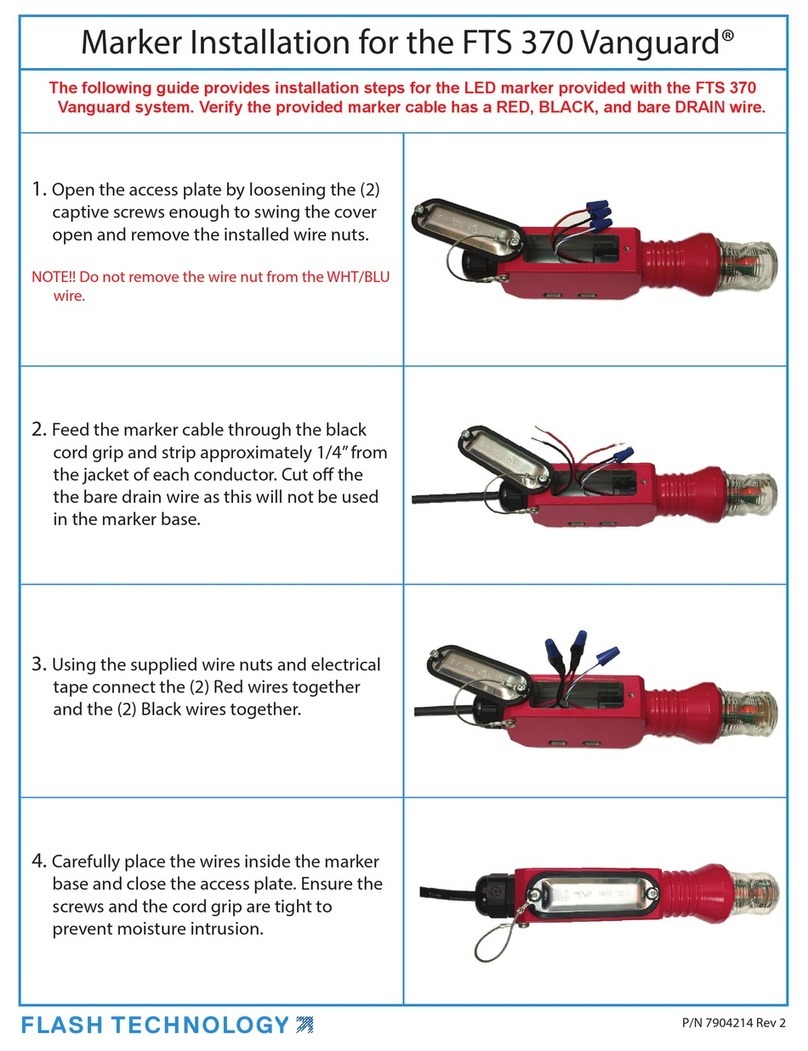
Flash Technology
Flash Technology Vanguard FTS 370 User manual
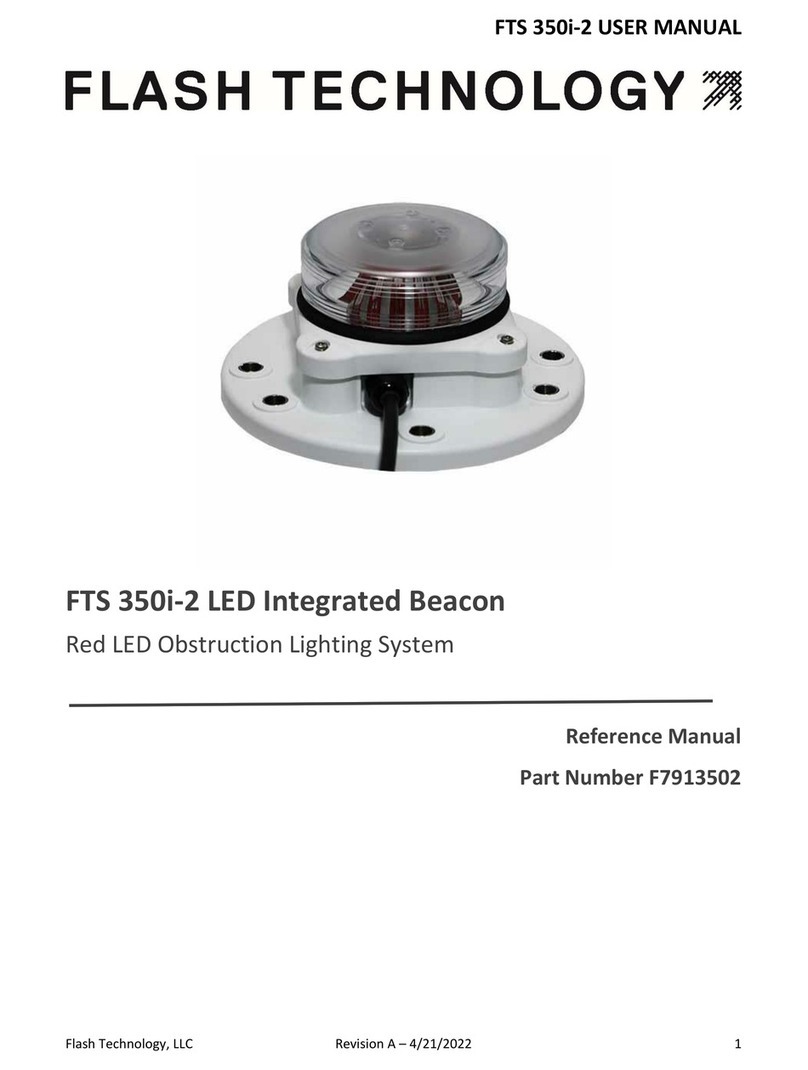
Flash Technology
Flash Technology FTS 350i-2 User manual
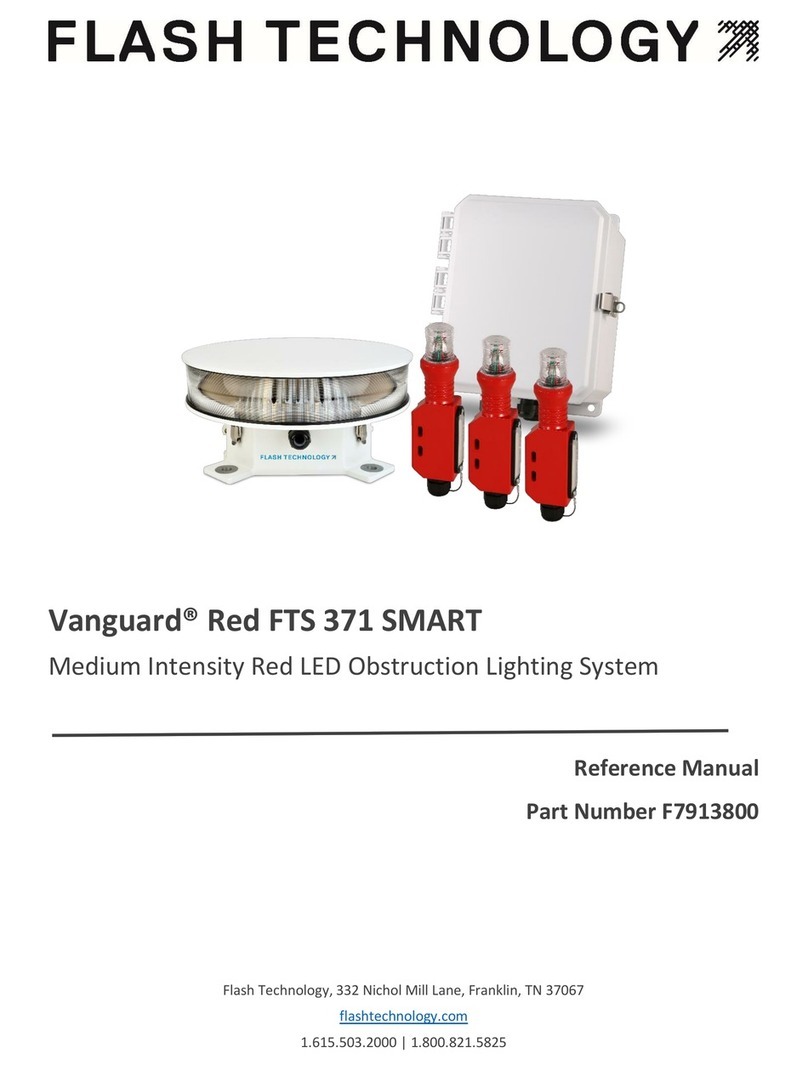
Flash Technology
Flash Technology Vanguard Red FTS 371 SMART User manual
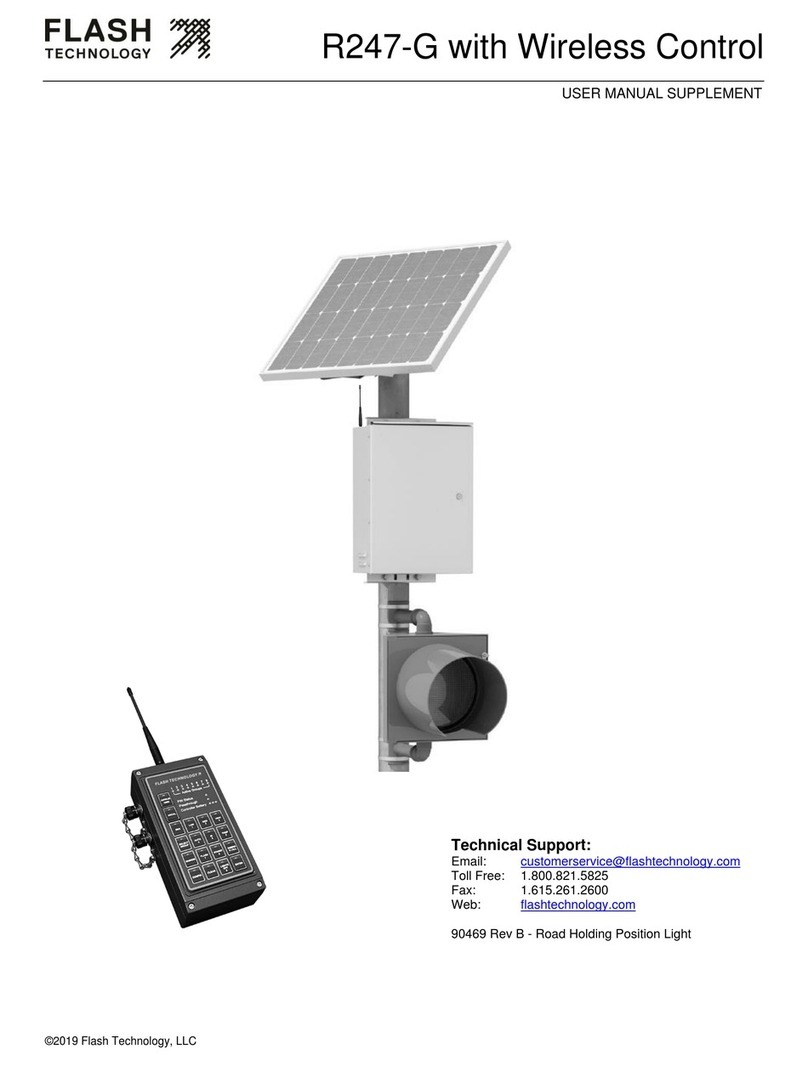
Flash Technology
Flash Technology R247-G User manual

Flash Technology
Flash Technology VANGUARD FTS 270 User manual

Flash Technology
Flash Technology Vanguard Red FTS 371 User manual
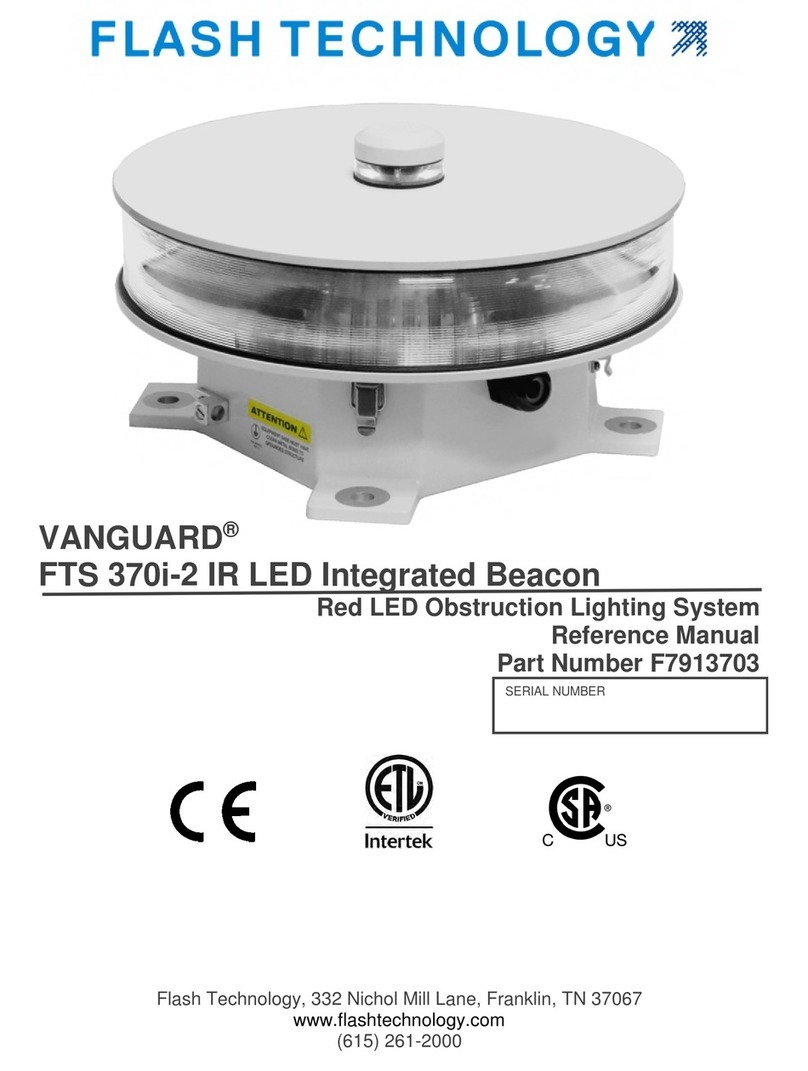
Flash Technology
Flash Technology VANGUARD FTS 370i-2 User manual
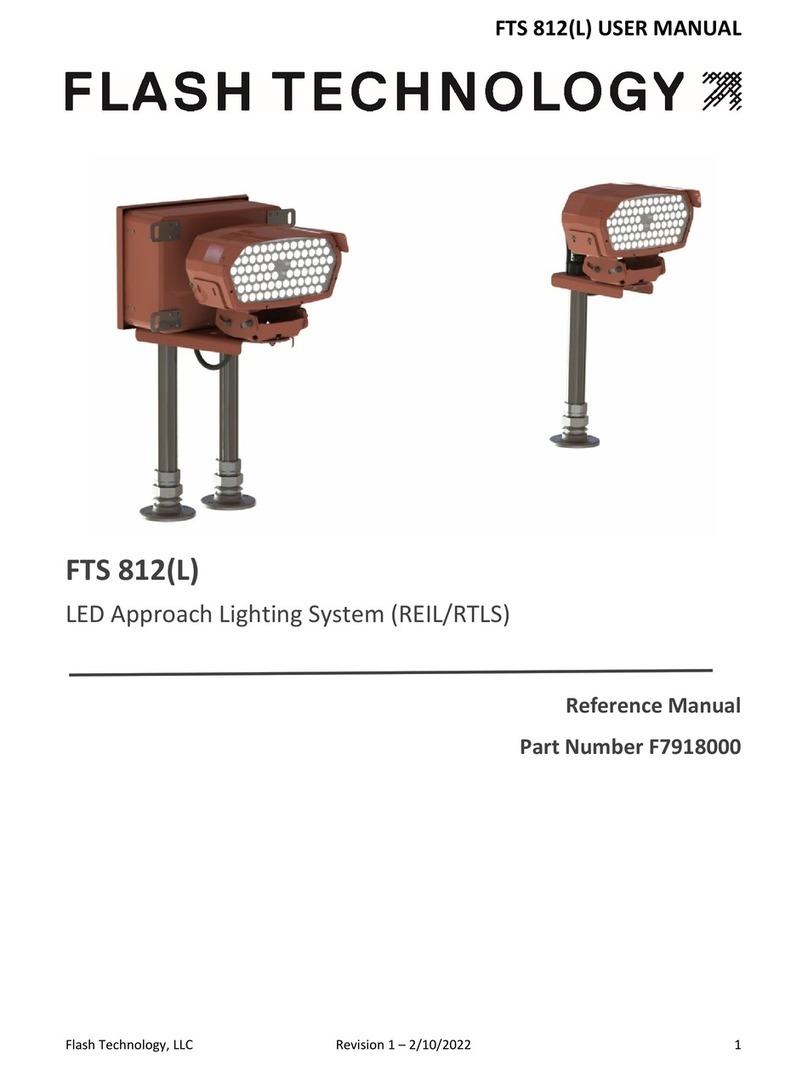
Flash Technology
Flash Technology FTS 812 L User manual
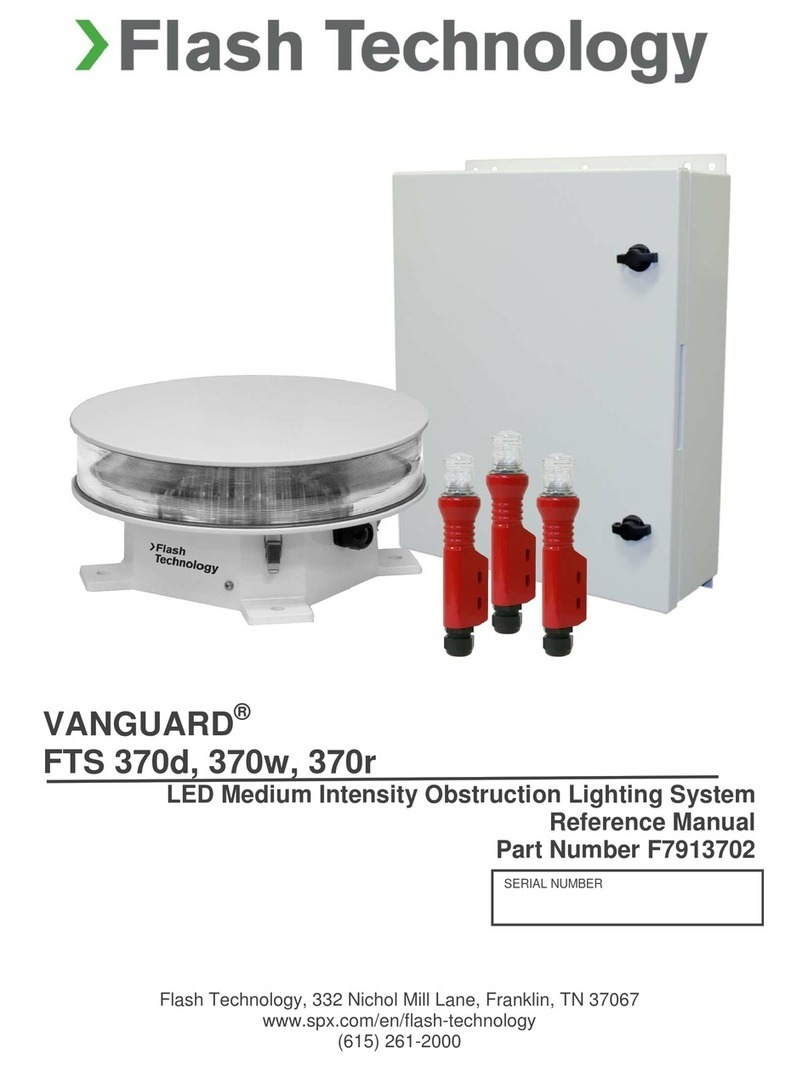
Flash Technology
Flash Technology VANGUARD FTS 370d User manual

